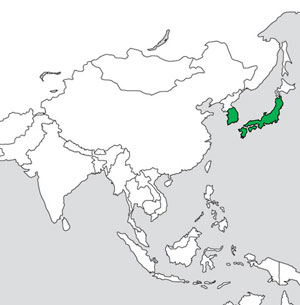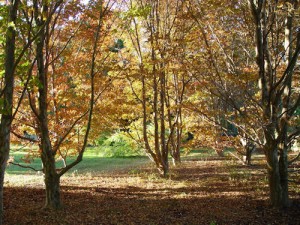Stewartia pseudocamellia (Japanese Stewartia)
|
|
|
|
Type: Deciduous tree
Hardiness Zone: 5-7
Sunlight: Full sun to part shade
Soil Moisture: Well drained
Soil pH: Acid
Flowering: June
Flowers: White
Leaves: Purple, red fall color
Bark: Exfoliating, contrasting colors
Height: 30 to 40 feet
Small trees to 20 m., usually with several limbs from a short trunk; periderm on young branches exfoliating in thin strips or flakes, the branchlets dark blackish- or silvery-gray, often zigzagged and compressed; bark smooth and mottled with alternating pinkish, brownish, and grayish areas; winter buds compressed, 7-11 mm. long, with 2-4 finely pubescent imbricated scales. Petioles 4-10(-15)mm. long, shallowly grooved on the adaxial surface; leaf blades broadly ovate to elliptical, (1.5-)3.5-11.5 cm. long, (1.5-) 2.5-6 (-8) cm wide, with acute to acuminate apices, shallowly serrate margins, the teeth with short, blackish points, and rounded to cuneate bases. Flowers axillary, rarely terminal, pedicels (0.8-) 1-4 cm long, seemingly increasing in length after anthesis; bracts subtending the calyx subopposite to distinctly alternate, much smaller than and closely appressed to the sepals, broadly reniform to oblong in outline with ciliate margins, sometimes with an acute apex, 4-8 mm. wide, 5-8 mm. long, the margins often overlapping laterally, persistent. Sepals 5, enclosing the flower in bud, thickened and connate at base, the free lobes subequal, suborbicular, 7-13 mm. long, (7-) 9-11 mm. wide, with rounded or occasionally acute apices, densely silky sericeous abaxial surfaces, and entire or ciliate margins; calyx persistent, almost totally enclosing the maturing capsule, remaining erect or often reflexed or partially deciduous in fruit. Petals 5, densely silky sericeous on the abaxial surface, connate at the base, suborbicular or scallop-shaped, 3-4.6 cm. long, (1.5-) 2-4 cm. wide, the margins wavy and erose. Stamens numerous, the filaments up to 20 mm. long, connate at the base into a tube ca. 5 mm. long, the tube adnate to the base of the corolla, the free filaments glabrous. Ovary conical, basally 5- or 6-lobed and densely pilose, 5-8 mm. long at anthesis, tapering into a glabrous 5- or 6-ribbed style 8-11 mm. long, the style terminating in 5 or 6 marginally ciliate stigmatic arms, the arms 1-2 mm. long. Capsules light to dark reddish brown, finely appressed-pubescent, ovoid with rostrate apices and strongly 5- or 6-angled, variable in size, (13-) 15-24 mm. long, (9-)11-18 mm. broad, dehiscing into 5 or 6 locules, the locule walls 6-8 mm. wide. Seeds 4 per locule, 2 often aborted, 5-8 mm. long, (3.5-) 4-5 mm. wide, reddish brown or purplish, ovate, obovate or oblong in outline with an obtuse apex, essentially wingless, the surface of the raised central portion puncticulate or often finely rugose. 2n = 30.
![]()
 GLOBAL DISTRIBUTION
GLOBAL DISTRIBUTION
Mountainous regions of North and Central Honshu, Kyushu, and Shikoku Islands, Japan, and in mountainous areas of the southern Korean peninsula; widely cultivated in western gardens.
![]() CULTIVARS
CULTIVARS
![]() Stewartia pseudocamellia ‘Ballet’ – “The seeds from which Stewartia ‘Ballet’ originated were collected by me on Bussey Hill in the Arnold Arboretum on October 20, 1966. First stratified, then planted, in February 1967, they germinated in 1968. In October of 1969, three young seedlings were planted in the arboretum, south, near the boundary wall, east of the grove of shagbark hickory trees. Four years later in January 1983, Ted Dudley registered the best one as Stewartia koreana ‘Ballet’, as he was Registrar at the U.S. National Arboretum. Now a tall tree, after 30 or moryears, it carries a graceful, spreading of its branches. ‘Ballet’ blooms in July with 3½-inchwhite flowers. In October, 1984 AABGA Bulletin, vol. 18(4) p. 117 ‘Ballet’ was again registered as Stewartia pseudocamellia ‘Ballet’, Maximowicz. The plant seems to thrive, whether “on” or “because of” controversy in nomencIts form is more graceful than the normal upright regularity of the species. It would be desirable plant it in a sunnier site for maximum flowering. Viva taxonomy!” From the notes of Polly Hill
Stewartia pseudocamellia ‘Ballet’ – “The seeds from which Stewartia ‘Ballet’ originated were collected by me on Bussey Hill in the Arnold Arboretum on October 20, 1966. First stratified, then planted, in February 1967, they germinated in 1968. In October of 1969, three young seedlings were planted in the arboretum, south, near the boundary wall, east of the grove of shagbark hickory trees. Four years later in January 1983, Ted Dudley registered the best one as Stewartia koreana ‘Ballet’, as he was Registrar at the U.S. National Arboretum. Now a tall tree, after 30 or moryears, it carries a graceful, spreading of its branches. ‘Ballet’ blooms in July with 3½-inchwhite flowers. In October, 1984 AABGA Bulletin, vol. 18(4) p. 117 ‘Ballet’ was again registered as Stewartia pseudocamellia ‘Ballet’, Maximowicz. The plant seems to thrive, whether “on” or “because of” controversy in nomencIts form is more graceful than the normal upright regularity of the species. It would be desirable plant it in a sunnier site for maximum flowering. Viva taxonomy!” From the notes of Polly Hill
![]() Stewartia pseudocamellia ‘Cascade’ – Arching, cascading branches, semi-pendent shoot tips, 15′ to 12′ after 30 years; white flowers with golden yellow stamens; rich red-purple fall color.
Stewartia pseudocamellia ‘Cascade’ – Arching, cascading branches, semi-pendent shoot tips, 15′ to 12′ after 30 years; white flowers with golden yellow stamens; rich red-purple fall color.
![]() Stewartia pseudocamellia ‘Milk and Honey’ – “‘Milk and Honey’ grew from seed collected in the Arnold Arboretum. It has flowers different from the norm: the flowers are larger, to 4 inches across, ruffled, and they open flat—not cup-shaped. The honey comes from the mass of golden stamens in the center of each milk-white flower. Like others of the species it flowers in July, and in the fall it has orange-red, rather than purple, fall color. The shining silver-gray and cinnamon exfoliating bark is a splendid feature in older trees, most conspicuous in winter. To see stewartias at their best, give them plenty of moisture before blooming time. ‘Milk and Honey’ is growing in the “stewartia forest” near the Vegetable Field.” From the notes of Polly Hill
Stewartia pseudocamellia ‘Milk and Honey’ – “‘Milk and Honey’ grew from seed collected in the Arnold Arboretum. It has flowers different from the norm: the flowers are larger, to 4 inches across, ruffled, and they open flat—not cup-shaped. The honey comes from the mass of golden stamens in the center of each milk-white flower. Like others of the species it flowers in July, and in the fall it has orange-red, rather than purple, fall color. The shining silver-gray and cinnamon exfoliating bark is a splendid feature in older trees, most conspicuous in winter. To see stewartias at their best, give them plenty of moisture before blooming time. ‘Milk and Honey’ is growing in the “stewartia forest” near the Vegetable Field.” From the notes of Polly Hill
![]() Stewartia pseudocamellia ‘Mint Frills’ – “‘Mint Frills’ has different flowers, in that some—not all—of the blossoms on this tree, produce extra petals of pale green. The green comes from the silky hairy surface of the extra petal lying over the normal five. The whole effect is frilly and attractive. Given maturity and ample moisture ‘Mint Frills’ produces this occasional prize to be enjoyed. This tree is growing in the “stewartia forest” near the Vegetable Field, at the easternmost point of the triangle. Its fall color is orange-red, not purple. All the Korean stewartias produce abundant seeds. This tree receives high marks for strength and health, which translates into beauty.” From the notes of Polly Hill
Stewartia pseudocamellia ‘Mint Frills’ – “‘Mint Frills’ has different flowers, in that some—not all—of the blossoms on this tree, produce extra petals of pale green. The green comes from the silky hairy surface of the extra petal lying over the normal five. The whole effect is frilly and attractive. Given maturity and ample moisture ‘Mint Frills’ produces this occasional prize to be enjoyed. This tree is growing in the “stewartia forest” near the Vegetable Field, at the easternmost point of the triangle. Its fall color is orange-red, not purple. All the Korean stewartias produce abundant seeds. This tree receives high marks for strength and health, which translates into beauty.” From the notes of Polly Hill
Tree logo indicates introduction by Polly Hill
Descriptions from Stephen A. Spongberg, 1974, A Review of Deciduous-Leaved Species of Stewartia (Theaceae), Journal of the Arnold Arboretum 55: 182-214.
